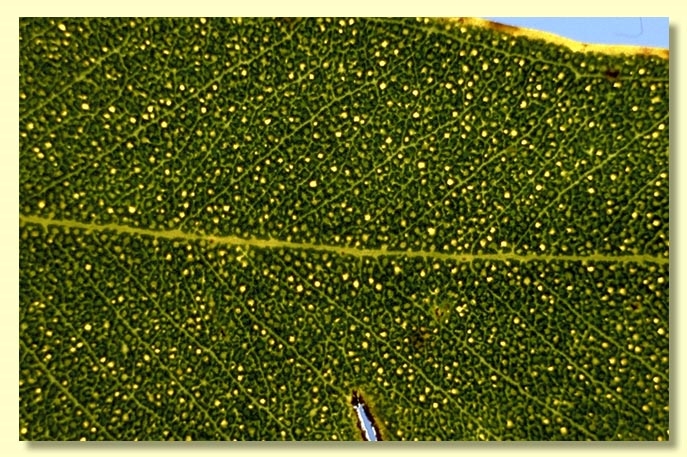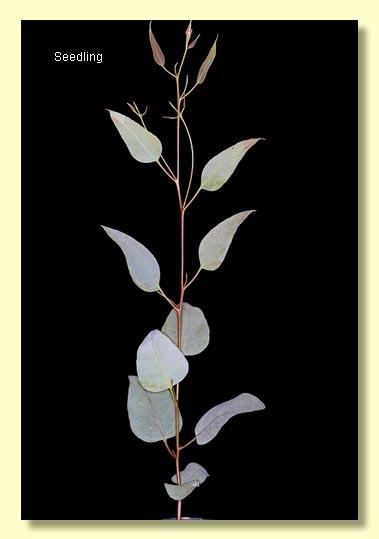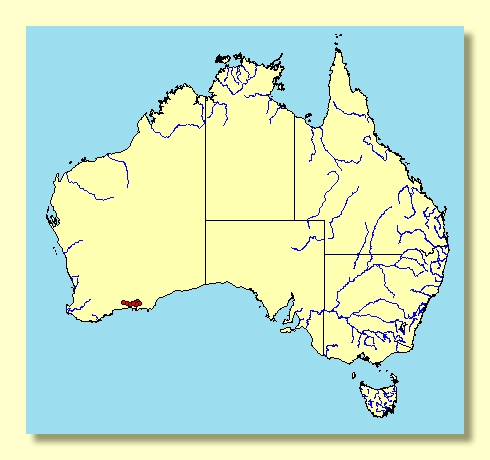Euclid - Online edition
Eucalyptus forrestiana
Eucalyptus | Symphyomyrtus | Dumaria | Tetrapterae
T: c. 50 km N of Esperance, W.A., Nov. 1901, L.Diels 5332; type specimen destroyed in World War 2 bombing of Berlin-Dahlem.
Bark wholly smooth, grey over pale brown.
Branchlets lacking oil glands in the pith.
Juvenile growth (coppice or field seedlings to 50 cm): stems rounded to square in cross-section; juvenile leaves always petiolate, alternate, ovate to lanceolate, 3–10 cm long, 2–6 cm wide, greyish green and dull.
Adult leaves alternate, petioles 1.2–2.8 cm long; blade narrowly oblong to lanceolate, 5.5–9.5 cm long, 1.5–2.5 cm wide, base tapering to petiole, margin entire or rarely distantly subcrenulate, apex pointed, concolorous, glossy when fully mature, green, side-veins greater than 45° to midrib, reticulation dense, erose, intramarginal vein remote from margin, oil glands mostly intersectional.
Inflorescence axillary unbranched, pendulous, peduncles flattened distally, 2.2–5.5 cm long, bud solitary, pedicel 1.3–2 cm long. Mature buds oblong, square in cross-section and narrowly winged (3.5–4.3 cm long, 1.1–2 cm wide), hypanthium red at maturity, scar present, inner operculum patelliform with a smooth necrotic and often split apex which may be the remains of the outer operculum (0.6–1 cm long), stamens inflexed, filaments glandular, anthers cuboid to globular, versatile, dorsifixed, dehiscing by longitudinal slits, style long and straight, stigma tapered to rounded, locules (3)4, the placentae each with 6, 8 or 10 vertical rows of ovules. Flowers yellow.
Fruit pedicellate (pedicels 1–2.7 cm long), oblong in outline, 4-angled and narrowly winged, 3.5–5 cm long, 1.7–3.3 cm wide, disc descending vertically, valves (3)4, enclosed.
Seeds black, 3–5 mm long, obliquely pyramidal or flattened, prominently ridged and with marginal flange, dorsal surface shallowly reticulate, hilum more or less terminal.
Cultivated seedlings (measured at ca node 10): cotyledons reniform; stems rounded to square in cross-section; leaves always petiolate, opposite for 4 or 5 nodes then alternate, ovate, 7–9.5 cm long, 3–5 cm wide, dull, green.
Flowering has been recorded in January.
A mallet endemic to Western Australia, of restricted subcoastal distribution north of Esperance extending from the Cascades area east to near Mt Ney and Mt Beaumont. The bark is smooth and the adult leaves mostly elliptical, maturing glossy, green to olive-green. The operculum is very flat.
Eucalyptus forrestiana belongs in Eucalyptus subgenus Symphyomyrtus section Dumaria because the buds have two opercula, stamens are strongly inflexed, ovules are in six, eight or 10 rows on the placentae and cotyledons are reniform. E. forrestiana forms a small subgroup (series Tetrapterae) with E. stoatei, E. tetraptera and E. dolichorhyncha, all with single-flowered inflorescences that are ultimately red, all lacking oil glands in the pith of the branchlets, and with blackish pyramidal seed.
E. forrestiana is distinguished from its near relatives by the combination of very flat disc-like operculum and the four-winged buds and fruits with intervening shallow ribs. It is most similar to, but less well-known than, E. dolichorhyncha which has long been a horticultural favourite in southern Australia and was once referred to as E. forrestiana.













